RogueRose
International Hazard
    
Posts: 1585
Registered: 16-6-2014
Member Is Offline
|
|
Purifying ammonium sulfate fert
I have some pretty nasty looking ammonium sulfate. It is in normal fertilizer bead/prill size but it is brownish to dark yellow. When added to water
it turns to black water with a disgusting foam on top that can be skimmed off and it eventually goes away.
I first tried heating the solution to dissolve as much sulfate and then gravity filter - then evaporate, but I think it was decomposing at 212 around
the edges of the evap pan as it would be way to slow to do it with a fan and low heat (I used 300-350F)
So I decided to heat to 205F with an excess of fert and pour the liquid through very fine mesh filter (catch undissolveables - fert & black dirt
specks - like creosote flakes..) and then chilled to 0c (or lower at points, IDK how that effects sulfates...) where about 1/3 of the sulfate would
form crystals. I then filter through a fine cloth again, keeping the new crystals. I squeeze and use centrifugal spinning to help get the liquid out
of the crystals.
Next I repeat entire heating & dissolving, filtering, cooling/crystalizing, filtering, etc.
The thing is that I have crystals that are not exactly pure. They have a grey brown tint and still some moisture. When I dry them out, they do
whiten up a good bit, but I suspect tha there is still "dirt" in there.
I tried washing the crystals with acetone and that didn't work at all. I finally got them to mix around and I thought any remaining black/brown that
was in them (I think it is tar from production from coal). but teh acetone didn't seem to absorb anything. I have no methanol but I have vodka and
isopropyl 91% if that may help.
The last resort is to use water to wash and I end up getting beer color water and loose a good bit of my crystals.
I'm working on some filtration setups as it seems that the contaminates are attracted to cotton and stick pretty well (and actually rinse off
afterwards). The problem is how do I evaporate 3-5 gals water without boiling and decomposing the sulfate to bisulfate at 212F?
What I have been doing is just constantly filtering the waters (still saturated for room temp) with gravity fed (man i need to figure out a powered
system!!) and I can get very light (like 6:1 water:apple juice) after filtering with good clean slow filters.
What is the best way to go about doing this? There has to be something I'm missing (that isn't vacuum distillation).
[Edited on 13-1-2016 by RogueRose]
|
|
|
Bert
Super Administrator
        
Posts: 2821
Registered: 12-3-2004
Member Is Offline
Mood: " I think we are all going to die. I think that love is an illusion. We are flawed, my darling".
|
|
Your contaminant is likely Fe- Probably as a sulfate initially, possibly as a hydroxide after heating.
As far as water removal, it may not be required until you achieve your final destination product, which might simplify the process. Could you specify
what the ammonium sulfate is to be used for, how pure it needs to be?
If you happen to have a big bag of fertilizer grade Calcium nitrate and a big bag of fertilizer grade ammonium sulfate? I can conjecture... Obviously,
you are a commercial blueberry grower 
There are a couple of existing threads here regarding exactly this OTC material and purification methods. And some about very noisy blueberries. I
could merge?
Rapopart’s Rules for critical commentary:
1. Attempt to re-express your target’s position so clearly, vividly and fairly that your target says: “Thanks, I wish I’d thought of putting it
that way.”
2. List any points of agreement (especially if they are not matters of general or widespread agreement).
3. Mention anything you have learned from your target.
4. Only then are you permitted to say so much as a word of rebuttal or criticism.
Anatol Rapoport was a Russian-born American mathematical psychologist (1911-2007).
|
|
|
Praxichys
International Hazard
    
Posts: 1063
Registered: 31-7-2013
Location: Detroit, Michigan, USA
Member Is Offline
Mood: Coprecipitated
|
|
When you wash your crystals, are you using ice water? It should be so cold that it is starting to freeze. Otherwise the washing will cause heavy
losses.
You could also try adding a flocculation agent to accumulate particles of dirt or tar during the boiling process. Add a few scoops of diatomaceous
earth/bentonite clay/activated carbon/celite, etc. during the boil, and see if it clarifies and settles the dirty solution upon cooling/prolonged
standing.
Failing that, I'd try adding a bunch of ammonia to get metals to precipitate as their hydroxides, then retry the flocculation procedure.
|
|
|
UC235
National Hazard
   
Posts: 565
Registered: 28-12-2014
Member Is Offline
Mood: No Mood
|
|
Quote: Originally posted by Praxichys  | | When you wash your crystals, are you using ice water? It should be so cold that it is starting to freeze. Otherwise the washing will cause heavy
losses. |
That will barely help. Ammonium sulfate's solubility in ice water is 70g/100ml. At room temp it's only 74g/100ml.
I'd say to chuck it in a flask with NaOH for an ammonia generator. The contaminants are very likely non-volatile. If you need clean ammonium sulfate,
neutralize some aq. NH3 with clean sulfuric acid, but I suspect you don't.
|
|
|
Praxichys
International Hazard
    
Posts: 1063
Registered: 31-7-2013
Location: Detroit, Michigan, USA
Member Is Offline
Mood: Coprecipitated
|
|
Quote: Originally posted by UC235  | | That will barely help. Ammonium sulfate's solubility in ice water is 70g/100ml. At room temp it's only 74g/100ml. |
Yes, but think about the kinetics of dissolution - dissolving 70g into 100ml of cold water will take far longer than 74g into 100ml of room temp
water. Certainly a few seconds of washing is not enough to saturate the filtrate. The gains in practice are much larger than simple solubility would
suggest.
Crystal size is also a big factor, which makes this hard to quantify. With a multi-liter solution I assume the cooling rate is low, and thus the
crystals are fairly large. Obviously, finer crystals provide less benefit from washing cold.
|
|
|
chloric1
International Hazard
    
Posts: 1070
Registered: 8-10-2003
Location: GroupVII of the periodic table
Member Is Offline
Mood: Stoichiometrically Balanced
|
|
Sometimes the impurities are water soluble or at least form colloidal suspensions. When I worked with ammonium sulfate, filtering left me with a
pale yellow solution. I also noted that alcohols and acetone also dissolved whatever what was yellow. It was then I figured out I had organics with
considerably sized molecules. I made a solution of my yellow sulfate along with a couple ounces of pet shop activated carbon and agitated. I was
left with a water white solution.
[Edited on 1/13/2016 by chloric1]
Fellow molecular manipulator
|
|
|
RogueRose
International Hazard
    
Posts: 1585
Registered: 16-6-2014
Member Is Offline
|
|
Quote: Originally posted by Bert  | Your contaminant is likely Fe- Probably as a sulfate initially, possibly as a hydroxide after heating.
As far as water removal, it may not be required until you achieve your final destination product, which might simplify the process. Could you specify
what the ammonium sulfate is to be used for, how pure it needs to be?
If you happen to have a big bag of fertilizer grade Calcium nitrate and a big bag of fertilizer grade ammonium sulfate? I can conjecture... Obviously,
you are a commercial blueberry grower 
There are a couple of existing threads here regarding exactly this OTC material and purification methods. And some about very noisy blueberries. I
could merge? |
The purchase of the various fertilizers is one of many that have been purchased but as of yet the only two that make the water absolutely filthy when
added in a 1:20 fert:water concentration. This is totally unacceptable if either if these were to be used in a hydroponics setup and will cause MAJOR
fouling of some equipment and will eventually ruin equipment.
Hydroponics ready fert can be 20x more expensive (or more) so I am doing some research on purification.
I alsohave about 10+ bags of other chems that I'm running purification tests on. I plan on publishing start to finish pics, how to's etc when I'm
done.
|
|
|
hissingnoise
International Hazard
    
Posts: 3940
Registered: 26-12-2002
Member Is Offline
Mood: Pulverulescent!
|
|
| Quote: | I can conjecture... Obviously, you are a commercial blueberry grower 
|
I grew it years ago ─ too Indica-dominant and too smelly!
My current PurpleHaze/OTH et al gives me what I like in a smoke . . .
|
|
|
Bert
Super Administrator
        
Posts: 2821
Registered: 12-3-2004
Member Is Offline
Mood: " I think we are all going to die. I think that love is an illusion. We are flawed, my darling".
|
|
If you intend to use ammonium sulfate for hydroponics, why try to reduce it to a dry powder after cleaning it up? You will just need to dissolve it
again for your end use.
Several others posting here on cleaning up ammonium sulfate are using with cheap Calcium nitrate fertilizer to obtain ammonium nitrate.
I do use ammonium sulfate for fertilizing blueberries as we don't have granite bedrock, my orchard soil is not quite acidic enough. I just spread it
on the soil in early spring and let it dissolve into the soil.
Looking forward to your opus on purifying bulk OTC fertilizer chemicals-
Rapopart’s Rules for critical commentary:
1. Attempt to re-express your target’s position so clearly, vividly and fairly that your target says: “Thanks, I wish I’d thought of putting it
that way.”
2. List any points of agreement (especially if they are not matters of general or widespread agreement).
3. Mention anything you have learned from your target.
4. Only then are you permitted to say so much as a word of rebuttal or criticism.
Anatol Rapoport was a Russian-born American mathematical psychologist (1911-2007).
|
|
|
RogueRose
International Hazard
    
Posts: 1585
Registered: 16-6-2014
Member Is Offline
|
|
Quote: Originally posted by Bert  | If you intend to use ammonium sulfate for hydroponics, why try to reduce it to a dry powder after cleaning it up? You will just need to dissolve it
again for your end use.
Several others posting here on cleaning up ammonium sulfate are using with cheap Calcium nitrate fertilizer to obtain ammonium nitrate.
I do use ammonium sulfate for fertilizing blueberries as we don't have granite bedrock, my orchard soil is not quite acidic enough. I just spread it
on the soil in early spring and let it dissolve into the soil.
Looking forward to your opus on purifying bulk OTC fertilizer chemicals- |
Well Amm Sulf seems like a good starting point for a lot of compounds and it is a pretty decent fertilizer. The purification is an exercise in
learning various aspects of compounds and how things react with each other. To me it is like a puzzle of sorts.
If the fert is going to be used outside, it will be used as-is but if I were to use it in a hydroponics setup I think I would purify it first.
|
|
|
AJKOER
Radically Dubious
    
Posts: 3026
Registered: 7-5-2011
Member Is Offline
Mood: No Mood
|
|
You do realize that one can prepare pure aqueous (NH4)2SO4 easily and quickly from high purity bath salt (Epsom salt is MgSO4 with low heavy metal
impurities as people bathe in it and could absorb those toxins through their skin) and passing NH3 vapors through it by heating household ammonia, for
example. Just cool and separate off the Mg(OH)2.
Albeit, a little more expensive up front, but impurities largely eliminated which otherwise may surface as a bigger problem latter!
In doing the math, remember that your time and labor is really not free either.
[Edit] If you are interested in manufacturing your own aqueous (NH4)2SO4, may I suggest a relatively simple recently invented route (see, "Hydrogen
production via photocatalytic oxidation of aqueous ammonium sulfite solutions", by Cunping Huanga, et al.). To quote from the extract:
"The main process, unique to the S-NH3 cycle, is the visible light-induced photocatalytic oxidation of ammonium sulfite (NH4)2SO3) with
production of hydrogen and ammonium sulfate ((NH4)2SO4). The (NH4)2SO4 product is processed to generate oxygen and recover NH3 and SO2, which
are then recycled and combined with water to regenerate (NH4)2SO3 forming a closed cycle. In this paper, we report our experimental findings
with regard to the photocatalytic oxidation of aqueous (NH4)2SO3 solutions containing suspended platinum-doped cadmium sulfide (Pt/CdS) particles
irradiated by a xenon arc lamp. We achieved energy conversion efficiencies (absorbed light to chemical energy of hydrogen) of about 12%. The
photocatalyst remained active for more than 70 hrs. "
Link: https://www.google.com/url?sa=t&source=web&rct=j&...
In your embodiment, I would pass clean air through burning pure sulfur as a source of SO2 and pass air through heated aqueous ammonia, and then
combine the streams to form the ammonium sulfite (NH4)2SO3) in distilled water. Then add a suspension of 1% Pt doped CdS. While treating the resulting
solution to sunlight in shallow pans, maintain the temperature at least at 50 C for best conversion. Heating the final solution to over 65 C and pass
air into it should remove any remaining ammonium sulfite (decomposition temperature) or ammonia. Filter to recover the Pt/CdS catalyst.
Only major concern, perform a small scale test run and check soluble Cadmium content of final (NH4)2SO4 solution and/or final Cd levels in grown
plants. Major issue is the employment of chlorinated water which may form trace amounts of soluble CdCl2 from CdS.
[Edited on 15-1-2016 by AJKOER]
|
|
|
aga
Forum Drunkard
    
Posts: 7030
Registered: 25-3-2014
Member Is Offline
|
|
Purified some of my 25kg sack of ammonium sulphate last week.
Simply dissolve the fertiliser in a minimum of hot water then filter the solution.
Boil down to about 75% volume then allow to cool slowly.
Much purer crystals will form and sink to the bottom.
(if they don't, boil it down some more and let cool again).
Pour off the watery top layer (important: this is where the crud is) spread out your crystals and allow to dry.
If you want really pure crystals, repeat this recrystallisation process once or twice.
Not a fast or fancy process, but it works for many substances which dissolve much better in hot solvent than cold.
|
|
|
RogueRose
International Hazard
    
Posts: 1585
Registered: 16-6-2014
Member Is Offline
|
|
Quote: Originally posted by aga  | Purified some of my 25kg sack of ammonium sulphate last week.
Simply dissolve the fertiliser in a minimum of hot water then filter the solution.
Boil down to about 75% volume then allow to cool slowly.
Much purer crystals will form and sink to the bottom.
(if they don't, boil it down some more and let cool again).
Pour off the watery top layer (important: this is where the crud is) spread out your crystals and allow to dry.
If you want really pure crystals, repeat this recrystallisation process once or twice.
Not a fast or fancy process, but it works for many substances which dissolve much better in hot solvent than cold. |
That is kind of what I was thinking of doing - process wise - but I was adding a filtration process in there when in solution.
After my filter process I kept the crystals that formed while the solution was sitting above the filter (gravity filter), washed with cold ammonia
solution, added them back to filtered solution and heated to dissolve again.
This time I allowed to cool slowly and when at room temp I added a fan. This is what I got from room temp evap.
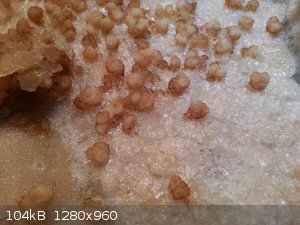
Notice the crystals are pretty white/clear and then there are "pillars" that look totally diffeent and are darker. They seem to consist of very fine
powder/crystals vs the much larger and clearer crystals that can be seen.
Could these "pillars" be the bisulfate? Wiki says at 100C Amm Sulf decomposes to bisulfate so if the water boils, is that going to decompose the
sulfate - leaving what you see as the final product?
I noticed in another thread that the bisulfate can be converted back to the original sulfate by mixing in an ammonia solution. I have yet to try this
but I guess I could test some of these pillars with that process and see if it changes the way they form.
Can anyone identify these or whether if it is a normal crystalization process of some kind?
|
|
|
aga
Forum Drunkard
    
Posts: 7030
Registered: 25-3-2014
Member Is Offline
|
|
Quote: Originally posted by RogueRose  |
That is kind of what I was thinking of doing - process wise - but I was adding a filtration process in there when in solution. |
Can you not read Logan ?
|
|
|
woelen
Super Administrator
        
Posts: 7977
Registered: 20-8-2005
Location: Netherlands
Member Is Offline
Mood: interested
|
|
The brown stuff definitely is not the bisulfate. The bisulfate of ammonium is colorless/white. The brown stuff simply is crap. I would carefully
remove the brown material and keep the white crystalline material. The white crystalline material looks reasonably pure to me and most likely is good
enough for most chemistry experiments. The brown stuff can be kept around. Good for making ammonia gas by adding NaOH and a small amount of water.
|
|
|
Bezaleel
Hazard to Others
  
Posts: 444
Registered: 28-2-2009
Member Is Offline
Mood: transitional
|
|
In case the brown stuff is iron related, you could add some ammonia solution and then filter. Iron hydroxides/hydrated oxides are usually coarse, so
can be filtered out easily.
|
|
|
Fyndium
International Hazard
    
Posts: 1192
Registered: 12-7-2020
Location: Not in USA
Member Is Offline
|
|
Bentonite slurried with blender is an excellent suspension clarifier. I have used it in many instances, first in winemaking and then it migrated into
chemistry. Just make sure it does not react with any acid or base.
Determining the impurity usually gives option to remove it, aside from just recrystallizing the product. Activated carbon can also do wonders
sometimes.
|
|
|
macckone
International Hazard
    
Posts: 2159
Registered: 1-3-2013
Location: Over a mile high
Member Is Offline
Mood: Electrical
|
|
I found a good purification method.
It involves dissolving the fertilizer in water to create a concentrated solution, filtering, then crashing out the ammonium sulfate with methanol
(other alcohols will work but it depends on the level of urea needing removal).
The ratio for methanol is 4 parts methanol to 1 part concentrated solution.
It appears this is used in commercial purification.
|
|
|
unionised
International Hazard
    
Posts: 5102
Registered: 1-11-2003
Location: UK
Member Is Offline
Mood: No Mood
|
|
The Ideal solvent for recrystallisation is one where the solubility is very low at low temperature, and high at a high temperature.
A saturated (at room temp) solution of ammonium sulphate dissolves little if any ammonium sulphate when cold, but dissolves plenty when it's hot, so
it's pretty much ideal.
So the trick is to recrystallize the stuff from the mother liquor from a previous recrystallisation.
Last time I tried this I found that there was a brown "tar" impurity in the fertiliser.
Most of it was removed by filtration of the hot solution.
Even more could be removed by washing (either the solid or the solution) with IPA.
Obviously, your fertiliser may contain different impurities.
|
|
|
RogueRose
International Hazard
    
Posts: 1585
Registered: 16-6-2014
Member Is Offline
|
|
I got the same black tar in mine when I purified it. I find it curious that this black tar seems to be in all batches of ammonium sulfate. I'm
really curious as to what it is. IIRC, I think the H2SO4 that is often used to make this stuff is often first used in steel mills to remove mill
scale from the metal or to clean the metal after the scale is blasted off. I wonder if there is some grease from the milling process that the metal
goes through.
IIRC I filtered with cotton and passed it through an activated carbon filter at the end and it came out crystal clear, no need for a solvent. I
suspect if I had added some powdered/dust AC to the solution and stirred it well, it would have filtered easier and I would have gotten it clear with
just passing it through the cotton as the tar/discoloration would have stuck to the AC and been captured before it got to the cotton filter.
|
|
|
Twospoons
International Hazard
    
Posts: 1282
Registered: 26-7-2004
Location: Middle Earth
Member Is Offline
Mood: A trace of hope...
|
|
I think you'll find its some kind of anti-caking agent deliberately added after prilling.
Helicopter: "helico" -> spiral, "pter" -> with wings
|
|
|
unionised
International Hazard
    
Posts: 5102
Registered: 1-11-2003
Location: UK
Member Is Offline
Mood: No Mood
|
|
The stuff I used wasn't prilled.
I presume that some ammonium sulphate is still made as a by-product of coke manufacture.
That would explain tarry impurities.
|
|
|
violet sin
International Hazard
    
Posts: 1475
Registered: 2-9-2012
Location: Daydreaming of uraninite...
Member Is Offline
Mood: Good
|
|
It helps if you have a rat die on top of a bucket of ammonium sulfate. I got a huge sack years back, Craigslist free listing. It was crystals locked
up on top and free flowing towards the bottom. The bag ripped and it was put into a bucket after picking up fully.
When the rat died there last fall... I decided to recrystallize the whole lot. Right before doing so, I freaking spilled some 100ish ml of power
steering fluid on half of it, laid out on plastic sheet to get twigs out. Garage clean up time was a disaster.
It was dissolved, skimmed off twigs and leaves, filtered through a cotton towel a few times (20) and evaporated in central valley sunshine. 6 or so
5gal buckets filled 1/3 the way, and two make shift trays that got topped off with concentrated solution and relieved of crystals. It sat out for
days as crystal crusts on a towel above a saturated sol. and is a pain to fully dry even in a black tray on 107°f day, without sol below it.
Plenty good for fertilizer now, and some big crystals growing in two buckets. They are needle like during most the day, but by late afternoon a
portion of them are more like BB sized multifaceted gaming die's. When it chills out at night, the needles come back.
They can stab right through the flesh of your trying to pick them up lol. One stuck, then melted in the moisture it encountered and toppled all slow
motion. The cleaning is easy. Never heated it with anything other than sunshine. Get your clean crystals out with a dirty solution left behind.
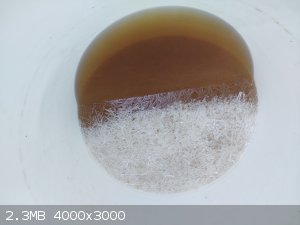 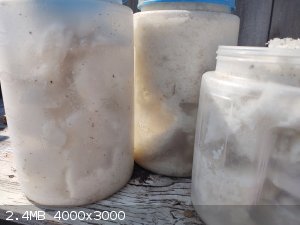
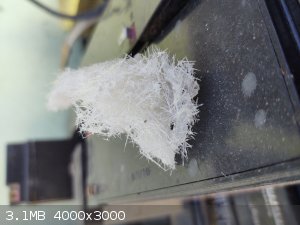 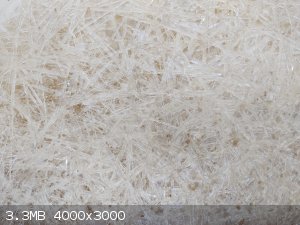
It's simple, just takes a ton of time. The cost of not wanting to dump 20 some odd pounds of fertilizer in the garbage or dealing with hazardous
materials disposal. Just a lot of material. My lawn can enjoy, and I'm happy doing the right thing.
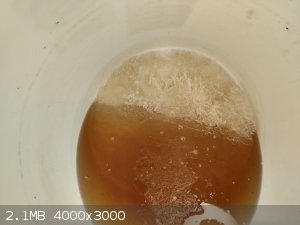
Same bucket as above, noticibly less crystals, it's warm from the days blasting of only 101°f. There are grainy crystals at the bottom like
mentioned.
[Edited on 2-8-2020 by violet sin]
|
|
|
RogueRose
International Hazard
    
Posts: 1585
Registered: 16-6-2014
Member Is Offline
|
|
Wow, I NEVER got anything that loooked like that, but I always evaporated quickly on the stove ( to about 80-90% dry) and then finished in the oven.
I still got pure white product but I'm going to have to try to get some that look like that!
But I have to say, my solution never looked that brown, mine was more black floating on top (I skimmed it off). I'll have to dig back through my
picutes. Thanks for reminding me of this, I kind of cut my teeth on this and CuSO4!!
|
|
|